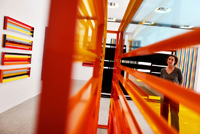 Leading Representative of Conceptual Art, Liam Gillick, Opens Exhibition in Bonn
Leading Representative of Conceptual Art, Liam Gillick, Opens Exhibition in BonnA woman eyes the installation 'screened reduction' by British artist Liam Gillick at Art and Exhibition Hall of the Federal Republic of Germany in Bonn, Germany. His exhibition 'One long walk, Two short piers' is on display from 01 April to 08 August 2010. EPA/OLIVER BERG
BONN.- Liam Gillick was born in England in 1964. Since the early 1990‟s he has been among the leading representatives of the continuing development of conceptual art. In 2009 he was chosen to design the German Pavilion at the 53rd Venice Biennale. The Art and Exhibition Hall of the Federal Republic of Germany has dedicated an extensive solo exhibition to Liam Gillick. This is the first show of its kind, not only in Germany but also internationally. About 60 works from two decades will be on display. The development of his oeuvre will be shown according to groups of works and themes from the late 1980‟s to his contribution for the German Pavilion in 2009.
The work of this artist, who lives in New York and London, cannot be allocated to any specific artistic media: he is at one and the same time, an object maker, painter, composer, curator and critic. Furthermore, Gillick can boast of an extensive list of publications which includes essays, critiques, fictional texts and theatre-related scenarios.
The show consists of five parts. It begins with an extensive text - work which slices diagonally through the exhibition area like a wedge. The German and English wall text consists of titles of works which were created between 1990 and 2004 with different media ranging from small works on paper to large sculptures.
Two further halls offer a retrospective insight. One focuses on the 1990‟s while the other provides insights into the development of Gillick‟s works after the year 2000.
For the artist, the 1990‟s were defined by developing central topics and strategies, formulating a specific aesthetic approach and direction, and finding a balance and mutual interactions between his artworks and the literary and theoretical texts that he produced at the same time. Selected works from the extensive groups McNamara Papers (1992-1995), Erasmus and Ibuka! Realisations (1994-1996) and The What If? Scenarios (1996-1998) enable the viewer to explore Gillick‟s early artistic path.
At the end of the 1990‟s Liam Gillick started producing works that can be summarised under the title Discussion Island, Big Conference Center. In many ways, the artworks come across as places which encourage discussion, in other words, a debate about the main questions in our society. Gillick created artworks as places for conversations, for discussions on the organisation of our society but also as places for the planning of future social model, so literary and political utopian visions appear as a basis for reflection and as failed attempts at creating a different society in the future.
Gillick developed artworks on the basis of this exploration of social utopias which also feature in his text Literally No Place, 2002.
The second hall comprises examples of works from the years after 2000 which show this development. In the middle of the last decade the artist concerned himself with the subject of a deserted factory under the heading Construccion de Uno (2004). After the plant had closed down, the workers returned and tried to find a new way to produce and to organise work. Examples from this group, which are based on the artist‟s utopian model, conclude the show. Volvo Bar (2008), one of two extensive installations, also belongs in this context. It was first shown in 2008 in the Munich Kunstverein and served as a setting for a short scenario in 8 acts by the artist.
The exhibition brings Gillick‟s work for the German Pavilion into connection with his whole oeuvre. The installation How are you going to behave? A kitchen cat speaks (2009) functions as the “projection” of a kitchen, a place for communication, conversation and discussion. Although planned from top to bottom, internationally standardised and serially produced, this private and familiar area allows for the freedom it offers to exist in a socially determined, standardised context. The analysis of the state of society never ends, not even in this unspectacular place where everyday life is lived.
With more than 350 illustrations, the exhibition catalogue presents a first overview of Liam Gillick‟s complex work. The main focus is on the last ten years. A series of significant exhibitions, projects, sculptures and site-specific, short-term interventions illustrate the development of an artistic approach which inspires basic questions regarding the possibilities and function of art in our social reality. This visual foray is supplemented by Liam Gillick‟s own notes, thought fragments and comments which to a large extent have been published for the first time.
 Leading Representative of Conceptual Art, Liam Gillick, Opens Exhibition in Bonn
Leading Representative of Conceptual Art, Liam Gillick, Opens Exhibition in Bonn